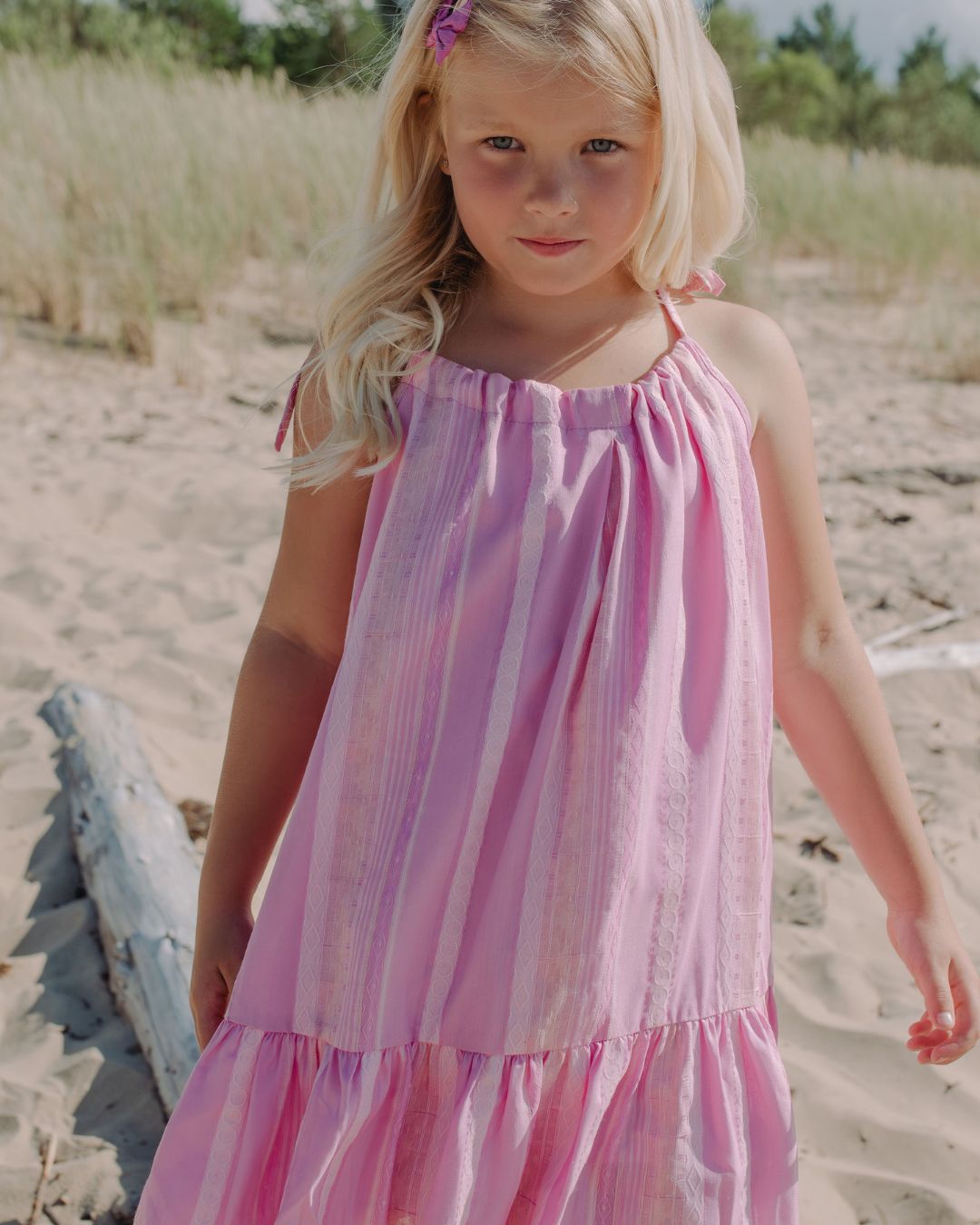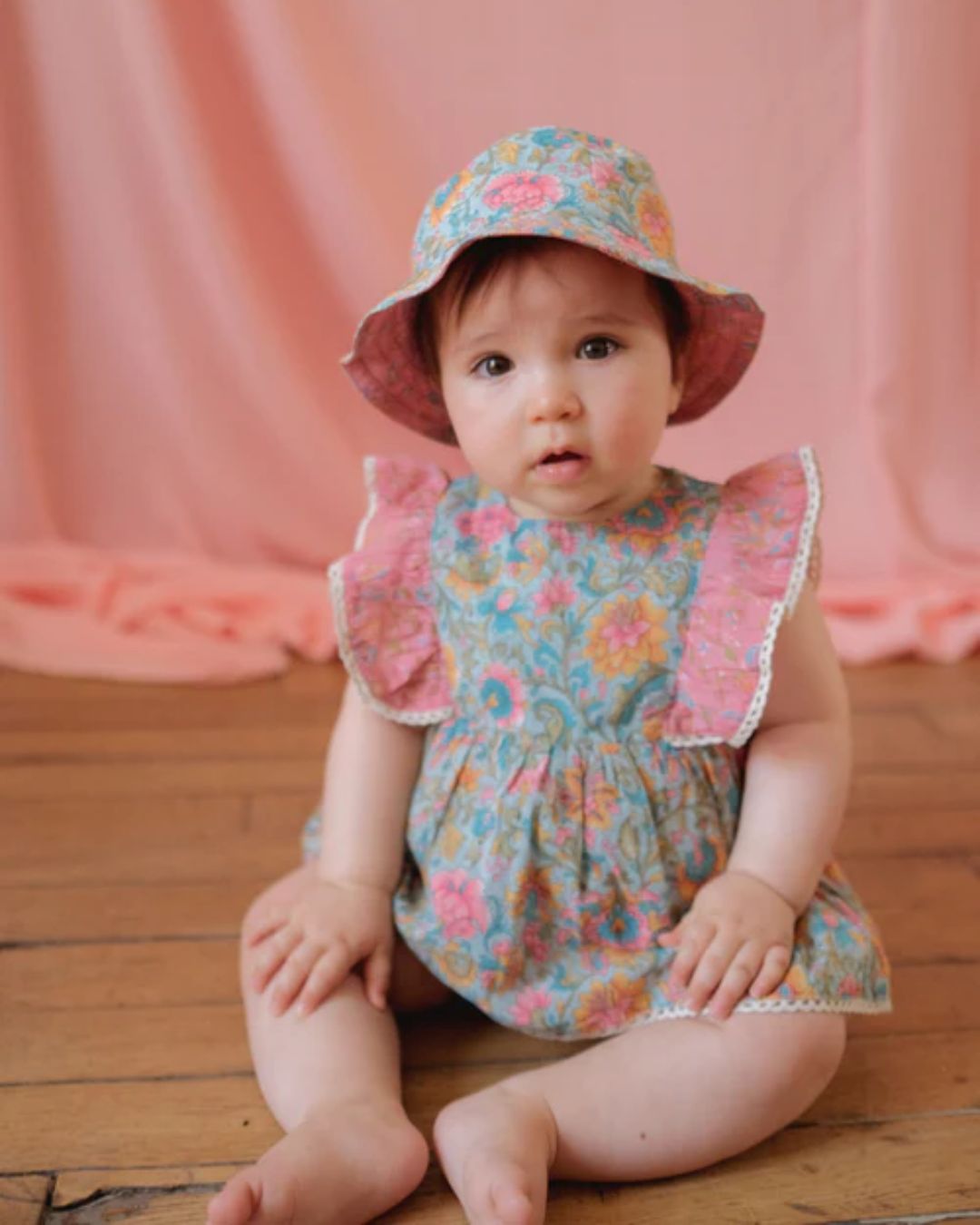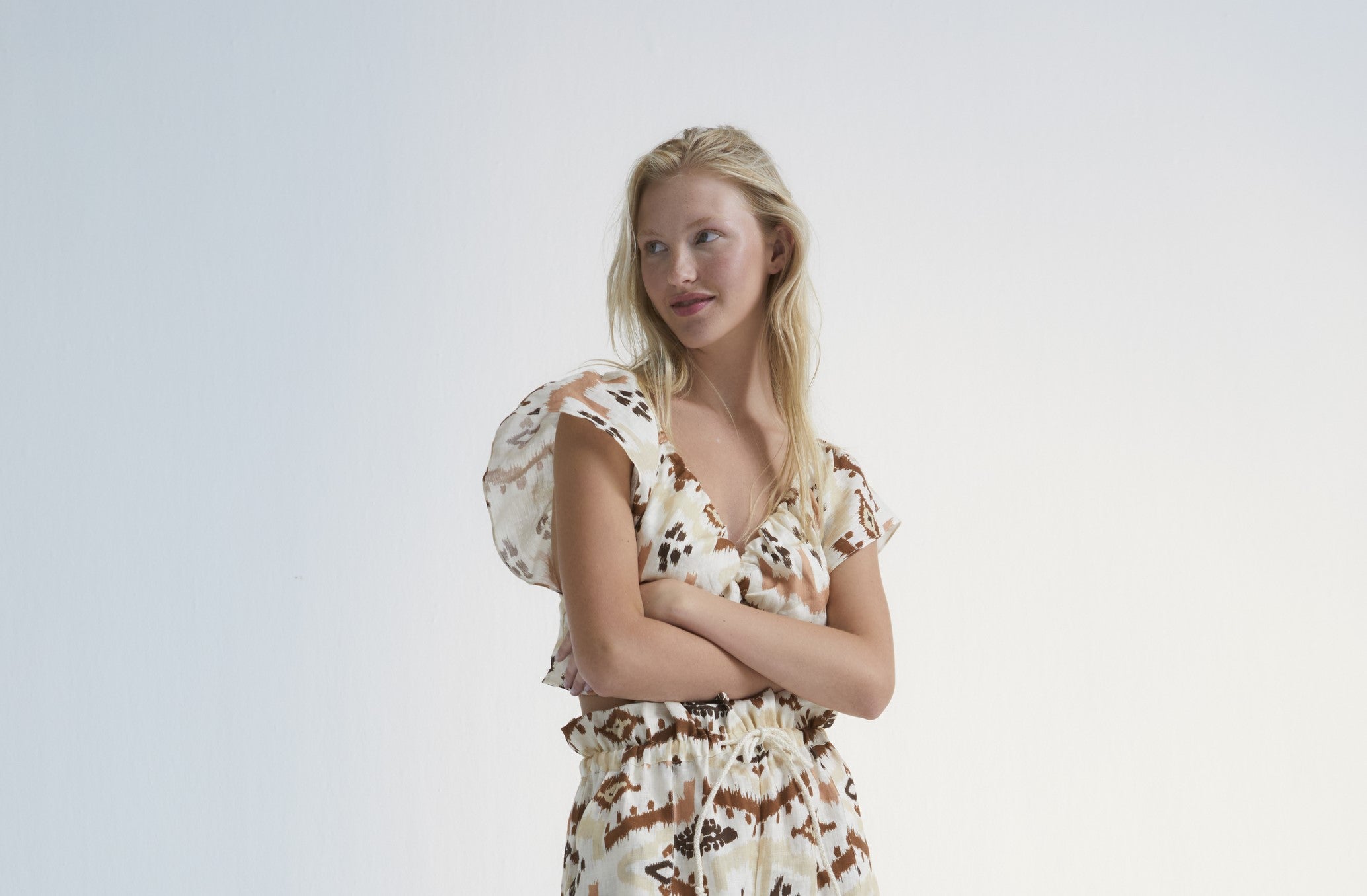11 Best Sensitive Skin Fabrics [Dermatologist-Tested for 2025]

After years of navigating my own sensitive skin challenges and watching my son battle severe eczema, I've learned which fabrics truly make a difference. This isn't just another list - it's what actually works when your skin reacts to everything
One of the main reasons MiliMIlu Lifestyle focuses on eco-friendly fabrics is that they are gentle on both your skin and the environment, avoiding harsh chemicals that can affect our skin and overall health. Our skin is our largest organ and absorbs what we wear, which can impact our skin, general health, and hormones.

Cotton
Cotton earned its place as my go-to fabric through trial and necessity, not marketing promises. When my son's eczema was at its worst and even the softest fabrics seemed to irritate his skin, organic cotton became our reliable constant. There's a reason dermatologists consistently recommend it - it simply works.
What makes cotton different for sensitive skin
Cotton's structure creates the perfect environment for reactive skin. Unlike synthetic fabrics that trap heat and moisture against your body, cotton allows air to move freely through its fibres. This isn't just comfort - it's crucial for preventing the hot, sweaty conditions that trigger flare-ups.
The moisture management impressed me most. Cotton can absorb up to 27 times its weight in water [14], which means it pulls sweat away from your skin rather than letting it sit there, causing irritation. During eczema outbreaks and more sensitive skin moments, organic cotton pyjamas made the difference between a restful sleep and hours of scratching.
The softness comes naturally from cotton's cellulose fibres. Each wash makes it gentler, not rougher like some fabrics. For families dealing with frequent laundry cycles - and trust me, sensitive skin means lots of washing - this durability matters.
Why cotton works for eczema
The National Eczema Society doesn't recommend cotton lightly [3]. It's about more than just comfort - cotton actively helps break the cycle that makes eczema worse.
Here's what cotton brings to sensitive skin:
-
Natural breathability that prevents overheating
-
Moisture absorption without that clammy feeling
-
Hypoallergenic properties that reduce reaction risks
-
High-temperature washing capability to eliminate irritants
That last point proved essential for us. Cotton handles hot washes (60°C or higher) that eliminate the skin cells, leftover creams, and allergens that can trigger new flare-ups [15]. Try doing that with synthetic fabrics - they'll either shrink or fall apart.
The organic cotton question
I used to think cotton was cotton until I learned about conventional farming practices. The nickname "the dirtiest crop on Earth" [16] sounds dramatic, but when you discover that traditional cotton uses 25% of all global pesticides [16], it becomes concerning for sensitive skin.
Organic cotton changes the equation entirely. No synthetic pesticides, no fertilisers, no genetically modified plants. For someone with chemical sensitivities or extremely reactive skin, these residues can be the difference between comfort and constant irritation.
The environmental benefits surprised me too. Organic cotton farming uses 91% less water than conventional methods [16] and avoids seven carcinogenic pesticides linked to serious health issues [16]. It's one of those rare situations where what's better for your skin is also better for the planet.
Shopping tip from experience: look for "100% cotton" labels, not "cotton rich" blends that sneak in polyester [3]. For the most sensitive skin, GOTS certification (Global Organic Textile Standard) guarantees no harmful chemicals throughout production.

Bamboo
Bamboo fabric intrigued me when I first heard about it a few years ago. With all the challenges we've faced finding suitable fabrics for sensitive skin in our household, I couldn't help but wonder... could this really be the gentle alternative everyone was talking about? The truth is, bamboo's story is more complex than the marketing suggests.
What's the deal with bamboo's antibacterial claims?
The antibacterial qualities of bamboo have been a subject of scientific investigation, with mixed results. Some studies indicate that bamboo fiber exhibits antibacterial efficacy against bacteria like E. coli and S. aureus, with tests showing a destruction rate of about 70% of bacteria after exposure [15] [14]. This antimicrobial property is attributed to a naturally occurring component in bamboo called "kun," which acts as a bacteriostatic agent [17].
However, the scientific community remains divided on this topic. Research from the Textile Verification Association of Japan confirms that bamboo fabric maintains its antibacterial properties even after 50 industrial washes [17]. Conversely, other studies suggest that natural bamboo fiber without chemical treatment does not inherently possess significant antibacterial qualities [18].
Honestly? The research makes my head spin sometimes. What I can tell you is that in our experience, bamboo has felt gentler than many other options we've tried.
How bamboo works for eczema-prone skin
For those dealing with eczema and sensitive skin conditions like we have, bamboo offers several potential benefits:
-
Superior moisture management: Bamboo absorbs up to three times its weight in water, effectively drawing moisture away from the skin [17]
-
Temperature regulation: The natural structure of bamboo fiber helps maintain stable body temperature, preventing the overheating that can trigger eczema flare-ups [18] [17]
-
Exceptional softness: Without chemical treatment, bamboo fibers are naturally smooth and round, lacking the sharp edges that can irritate sensitive skin [17]
According to the Eczema Association, bamboo ranks as one of the more suitable fabrics for sensitive skin after cotton [3]. Its breathability is reportedly 20% higher than cotton, with an absorption capacity 60% greater [14], making it particularly valuable for conditions where moisture control is crucial.
During those awful nights when my son's eczema would flare up from overheating, bamboo's cooling properties became a real lifesaver. It wasn't a miracle cure, but it definitely helped manage those temperature-triggered episodes that used to keep us all awake.
The environmental reality of bamboo fabric
Here's where things get complicated. Although bamboo as a plant is highly sustainable—growing rapidly without pesticides or fertilisers—the processing methods raise significant environmental concerns. The eco-credentials aren't as straightforward as we'd hope.
The predominant method for creating bamboo fabric involves chemical processing similar to rayon production, using sodium hydroxide and carbon disulfide—chemicals that can be harmful to workers and the environment [19]. This process turns bamboo into a semi-synthetic fiber called "bamboo viscose" that retains few of the original plant's properties [17].
A more environmentally friendly alternative is lyocell/TENCEL, derived from bamboo, which utilises a closed-loop manufacturing system that recycles almost 100% of the solvents used [3]. When considering bamboo for sensitive skin, it's essential to understand that the final fabric's properties depend significantly on the processing method, quality, and weave [17].
For those of us who care about both our skin and our planet, look for bamboo lyocell or products certified by OEKO-TEX, which ensures they're free from harmful substances [17]. It's one of those situations where doing a bit of research before buying really pays off.

TENCEL™ / Modal
I'll admit, I was sceptical about TENCEL™ at first. The name sounds synthetic, and after dealing with my son's severe eczema reactions to various fabrics, I wasn't eager to try another "innovative" material. But sometimes being wrong feels really good.
What makes TENCEL™ different
TENCEL™ comes from wood pulp - eucalyptus, beech, and spruce trees from sustainably managed forests [20]. What sets it apart is how it's made. The manufacturing process uses a closed-loop system where wood pulp gets dissolved in a non-toxic solvent called amine oxide, then filtered and spun into fibres. Here's what impressed me most: they recover and reuse 99.8% of the solvent [19]. Modal production follows a similar approach with high chemical recovery rates [2].
The technical specs tell the story:
-
Higher wet strength than traditional viscose (31-37 cN/tex compared to 12-14 cN/tex for viscose) [19]
-
Superior moisture absorption—50% more than cotton [12]
-
Natural breathability for temperature regulation [20]
Why it works for sensitive skin
The exceptionally smooth surface minimises friction against skin, which means less irritation and fewer triggers for eczema flare-ups [19]. TENCEL™'s moisture-wicking capabilities help maintain a dry skin environment, preventing bacterial growth that can worsen skin conditions [19]. Studies show patients with atopic dermatitis experienced less redness and itching when using TENCEL™ clothing [19].
What changed my mind was trying TENCEL™ bedding during one of my son's difficult periods. The fabric's temperature regulation helped prevent the night sweats that usually triggered his flare-ups. Sometimes the best discoveries happen when you least expect them.
Trust the certifications
TENCEL™ earned certifications that matter for sensitive skin:
-
EU Ecolabel for textile products, recognising high environmental standards [3]
-
OEKO-TEX® STANDARD 100 certification, ensuring it's free from harmful substances [2]
-
ISO certifications for quality, environmental, and safety standards [2]
-
FSC® or PEFC certification for responsibly sourced wood [2]
The production process uses 50% less carbon emissions and water than generic lyocell and modal fibres [2]. Yes, it costs more than conventional cotton, but for persistent skin sensitivities, the durability and skin benefits justify the investment [13]. Sometimes paying a bit more upfront saves you from dealing with reactions later.

Silk
Silk has a reputation for being fancy and impractical, but honestly? It's one of my secret weapons for dressing up and elevating my daily look. I used to think it was only for special occasions until I discovered how gentle it is on reactive skin.
Why silk feels so different on sensitive skin
What makes silk special isn't just the luxury factor - it's genuinely different from other fabrics. The fibres are incredibly smooth, which means they don't create that friction that can make sensitive skin worse. This natural protein fibre consists primarily of two proteins, sericin and fibroin, with sericin being naturally infection-resistant [4]. It actually repels common allergens like dust mites, mold, and bacteria that often trigger sensitive skin reactions.
The temperature thing with silk is pretty amazing too. The fabric's structure allows it to maintain a constant airflow while simultaneously insulating, creating what dermatologists describe as a "natural thermostat" effect [4]. For us dealing with sensitive skin issues, this means less of that sweating and overheating that can trigger flare-ups.
When I actually reach for silk
Here's the thing - silk isn't an everyday solution, but it's brilliant for specific situations. Unlike cotton, which soaks up moisture, silk lets your skin keep its natural oils [3]. I've found it most helpful for:
-
Nighttime, the most comfortable pyjamas
-
Pillowcases during those rough patches when even cotton feels scratchy
-
Times when his face is particularly sensitive
The silk pillowcases were honestly a game-changer, The Journal of Dermatology found that silk clothing reduced pruritus (itching) and redness better than cotton and synthetic fabrics in patients with atopic dermatitis [14]. Sometimes the gentlest touch makes all the difference.
The reality of caring for silk
Let me be completely honest - silk is high maintenance. It's expensive, and you can't just throw it in the washing machine with everything else. However, if you're dealing with particularly sensitive skin, sometimes the extra effort is worthwhile.
Here's what I've learned about silk care:
-
Hand wash with gentle, pH-neutral detergent
-
Never use bleach - it destroys the fibres [15]
-
Air dry only, away from direct sunlight [16]
-
If you dry clean, get it out of the plastic immediately to avoid chemical residue [15]
Look for "mulberry silk" specifically - it's the highest quality for sensitive skin. Certifications like OEKO-TEX confirm the absence of harmful substances throughout production [14]. Is it a lot of work? Yes. But when nothing else feels comfortable against irritated skin, silk can be worth every bit of extra care.

Linen
Linen's breathability and moisture-wicking
What makes linen special isn't immediately obvious when you first handle it. The secret lies in its structure - those loose weaves and natural fibres create excellent air circulation that keeps skin comfortable even on humid days. This breathability prevents that sticky, trapped feeling that often triggers skin irritation [17].
The moisture-wicking capabilities really impressed me once I gave linen a proper chance. It absorbs moisture without that clammy feeling you get with some fabrics, maintaining a comfortable dry sensation even in humid conditions [17]. During my son's summer flare-ups, when sweating would typically worsen his eczema, linen helped reduce those triggers.
There's something else quite lovely about linen that I discovered - the fabric has tiny breaks that gently massage the skin as you move, potentially improving blood flow [18]. For sensitive skin that needs gentle care, this natural stimulation can be surprisingly beneficial.
The roughness question (and why it matters less than you think)
Let's address the elephant in the room - yes, new linen feels rough. I won't pretend otherwise. When you first touch it, linen can feel scratchy compared to cotton or silk. But here's what changed my mind: this texture softens remarkably with each wash [17].
The transformation happens because pectin, a natural compound in the flax fibers, gradually dissolves through washing and wearing [19]. What starts as somewhat coarse becomes beautifully soft over time. It's like the fabric gets better with age, which feels quite fitting for those of us managing long-term skin sensitivities.
Despite that initial roughness, linen brings impressive hypoallergenic properties to the table. It naturally resists bacteria, mold, and dust mites - all common triggers for allergic reactions [17]. The antimicrobial qualities actually help reduce the risk of skin infections that can make sensitivity issues worse [20].
Finding linen that works for sensitive skin
Not all linen is created equal, especially when you're dealing with reactive skin. Here's what I've learned about choosing linen that will actually work:
Look for homeware-grade linen with long, fine fibers rather than the industrial-grade stuff used for upholstery [19]. The difference in softness is remarkable. If possible, find linen that's been garment-washed with enzymes - this accelerates the softening process before it even reaches you [19].
Certifications matter too. OEKO-TEX Standard 100 certification ensures the fabric is free from harmful substances, and Class 1 certification is deemed safe even for babies [19]. Given what we've been through with sensitive skin, these certifications provide valuable peace of mind.
My family's journey with linen taught me that patience pays off. Yes, it starts rough, but the breathability benefits come immediately, and the softness develops beautifully over time. Plus, avoiding synthetic alternatives means fewer chemical irritants - something our sensitive skin definitely appreciates.

DreamSkin® Technology Fabric
Sometimes you come across something that makes you think, "Why didn't someone create this sooner?" DreamSkin® technology is exactly that kind of discovery. When traditional fabrics weren't enough, this medical-grade approach caught my attention in a way that few fabric innovations have.
What is DreamSkin®
DreamSkin® takes a completely different approach than the natural fibers we've been talking about. Instead of relying on plant or animal origins, it's a unique polymer technology coating applied to fabrics that actually mimics how healthy skin behaves [21]. The base fabric is typically a blend of TENCEL and cotton (47% TENCEL, 48% cotton, 5% elastane), but the magic happens with that special coating.
The technology creates a protective layer that does two important things - it keeps moisture balanced while forming a barrier against all those irritants that seem to find their way to sensitive skin [22]. What really impressed me was learning that this wasn't just another fabric treatment, but something developed specifically because damaged skin can't manage moisture or temperature the way healthy skin does.
Clinical trials showed some pretty remarkable results - over 40% better cell survival when exposed to irritants compared to regular fabric [1]. The moisture recovery rate was three times higher than untreated materials [1]. Those numbers actually mean something when you're dealing with skin that reacts to everything!
How it helps break the itch-scratch cycle
Anyone who's watched their child go through that endless itch-scratch-itch cycle knows how heartbreaking it can be. DreamSkin® tackles this challenge in ways that surprised me:
-
Temperature control: The coating helps maintain just the right skin temperature, preventing that overheating that seems to trigger the worst itching episodes [23]
-
Smart moisture management: It lets skin breathe and sweat when needed, but keeps hydration locked in when that's what's required [24]
-
Protection from daily irritants: The polymer coating actually repels detergent residues and other common sensitivity triggers [23]
What's really fascinating is that DreamSkin® actually stimulates skin sensors that tend to "shut down" when eczema damages the skin [22]. This helps restore the natural moisture management system, slowly breaking that terrible cycle that keeps skin irritation going.
When DreamSkin® makes the most sense
This technology works best in sleepwear and undergarments - basically anywhere you have direct, extended skin contact. The British Skin Foundation has given these products their endorsement [23], and you'll find them marketed mainly for children with eczema through brands like M&S and Rejuvaskin. Adults dealing with persistent sensitivity issues can benefit just as much [25].
Throughout our journey with my son's eczema, I learned that sometimes you need to look beyond traditional solutions. DreamSkin® represents something different - instead of just providing a soft surface, it actually addresses what's happening underneath the fabric. For families dealing with stubborn skin sensitivities, it's worth exploring options that think outside the conventional fabric box.

Hemp was honestly the fabric I was most skeptical about when I started this journey. The name alone brought up all sorts of misconceptions, and I'll admit, I wasn't sure how something that strong could possibly be gentle on sensitive skin.
Hemp gets softer, not worse
Here's what surprised me most about hemp - it actually gets better with time. While most fabrics break down and become rougher, hemp does the opposite. This fabric is incredibly strong, measuring three to eight times stronger than cotton [26], but here's the thing that won the me over: it "wears in" beautifully [27].
When you first touch hemp fabric, it might feel a bit stiff. I remember thinking, "There's no way this will work for sensitive skin." But after just 3-4 washes, you start to notice the difference. Around the tenth wash, it's completely transformed into something soft and comfortable [27].
What's remarkable is that hemp's long, strong fibers maintain their integrity throughout all this washing, unlike cotton which tends to break down. We've had hemp shirts that have lasted twice as long as cotton ones [5], which makes the initial investment so much more worthwhile.
Why sensitive skin loves hemp
Hemp offers some really unique benefits for those of us dealing with reactive skin:
-
Naturally hypoallergenic - perfect for those with sensitive reactions [28]
-
Antibacterial properties - hemp naturally fights bacteria, fungi, and mold [29]
-
Breathable structure - allows air to flow freely, preventing that hot, humid environment where skin problems flourish [30]
Hemp can absorb up to 25% of its weight in moisture while still feeling dry against your skin [29]. For my son's eczema, this has been a game-changer. Plus, hemp naturally blocks 99.9% of harmful UV rays [30], which is an added bonus we didn't expect.
Hemp and caring for our planet
What really drew me to hemp was learning about its environmental impact. This plant requires 80% less water than conventional cotton [31] and grows without pesticides or herbicides because it naturally resists pests [5].
But here's what I find most amazing - hemp actually gives back to the soil. It returns 60-70% of the nutrients it takes, which means you can grow it on the same land for decades without depleting it [31]. Hemp also absorbs more carbon dioxide than trees, sequestering 3-6 tons of CO2 per acre compared to just 1-3 tons for trees [29].

SeaCell™
SeaCell™ sounds almost too good to be true - seaweed in fabric? When I first heard about it, I was honestly a bit skeptical. But after everything we've been through with my son's eczema, I've learned to keep an open mind about innovative solutions that might actually help and cannot wait to find out more about this fabric.
What is SeaCell™ fabric
SeaCell™ combines cellulose fibers with Ascophyllum nodosum seaweed through a patented process that's quite fascinating. The fiber contains at least 85% cellulose derived from wood pulp (typically beech or eucalyptus) and approximately 4% seaweed [7]. What impressed me is that it's produced using the Lyocell process—an eco-friendly production method that operates in a closed loop where 99.8% of solvents are recycled, preventing chemical waste [8].
The clever part is how the manufacturing process embeds seaweed permanently within the cellulose fiber, so its beneficial properties remain intact even after multiple washing cycles [8]. Clinical testing revealed only a 12-22% drop in effectiveness after 50 wash cycles [7], which is remarkable considering how frequently we need to wash clothes for sensitive skin conditions.
Skin-soothing properties from seaweed
Here's where it gets really interesting for those of us dealing with sensitive skin. The seaweed in SeaCell™ contains vitamins, trace elements, amino acids, and minerals that actually transfer to the skin through natural moisture exchange [8]. It's like giving your skin a gentle, continuous treatment while you wear the fabric.
These elements help activate cell regeneration, reduce inflammation, and soothe itchiness [8]. A randomized controlled trial published in Experimental Dermatology showed that silver-loaded SeaCell™ significantly reduced Staphylococcus aureus colonization in atopic dermatitis patients while improving barrier function [32]. For parents dealing with children's eczema, this kind of research gives hope that we're moving towards fabrics that don't just avoid irritation - they actually help healing.
Sustainability and innovation
What I love about SeaCell™ is how it addresses both skin health and environmental concerns. The European Union awarded its production process the 2000 European Environmental Award in the "technology for sustainable development" category [8]. The fiber itself is carbon neutral and completely biodegradable [33].
The harvesting process really shows respect for nature - they remove only regenerative parts of the seaweed, allowing it to regrow [8]. The material has earned both the EU Ecolabel and OEKO-Tex Standard 100 certification for baby products, confirming its safety for even the most sensitive skin [8].
It feels like we're finally seeing innovation that puts both people and planet first, which aligns perfectly with what I believe sustainable fashion should be about.

Merino Wool
Here's something that completely changed my perspective on wool... For years, I avoided anything wooly for my son's eczema-prone skin. The scratchy sweaters from childhood had left their mark, you know? But discovering ultra-fine Merino wool was honestly a revelation that made me question everything I thought I knew about sensitive skin and fabric choices.
The wool myth that needs to go away
I used to think wool was just off-limits for sensitive skin. Turns out, that's not actually true. A massive review looking at 100 years of research found no credible evidence that wool causes allergic reactions [34]. The real culprit? It's all about fiber thickness, not the wool itself [11].
When wool fibers are thicker than 30-32 microns, they're stiff enough to poke and irritate your skin - whether it's wool or synthetic doesn't matter [34]. My son's dermatologist explained it perfectly: those scratchy feelings aren't allergic reactions, they're just your pain receptors saying "ouch" to rigid fiber ends.
What makes ultra-fine Merino different
Ultra-fine Merino wool measures less than 17.5 microns in diameter, and this tiny difference changes everything [35]. These super-fine fibers bend instead of poking, which means they feel completely different against sensitive skin [34].
The research on this is pretty amazing. One study in the British Journal of Dermatology showed children with eczema actually improved when wearing superfine Merino compared to cotton [36]. Another study found real improvements in eczema severity scores for both kids and adults [36]. When I first read this, I was skeptical... but it made me curious enough to try.
When Merino still isn't right
Even with all these benefits, Merino doesn't work for everyone. The National Eczema Association is honest about this - some people with eczema love it, others find it irritating [37]. That's why I always recommend doing a patch test first, especially if you've had bad experiences with wool before.
If your skin is extremely sensitive, the micron count really matters. Look for products specifically labeled as 17.5 microns or less [36]. The good news is that Australia produces most of the world's superfine Merino [34], so quality options are becoming easier to find.
What surprised me most was how this challenged my assumptions about what fabrics could work for sensitive skin. Sometimes the solutions come from unexpected places...

Worst Fabrics for Sensitive Skin
Learning which fabrics to avoid has been just as important as finding the ones that work. Trust me, I've made my share of mistakes over the years - from buying that "cute" polyester dress that left me itchy all day to discovering the hard way that not all natural fabrics are created equal.
The synthetic fabric trap we've all fallen into
Synthetic fabrics like polyester, nylon, acrylic, and spandex have fooled many of us with their convenience and low prices. But here's what I've learned from years of dealing with my son's eczema - these materials are essentially plastic against your skin. They're hydrophobic, which means they trap heat and moisture instead of letting your skin breathe [38].
What makes this worse? The manufacturing process loads these fabrics with chemicals. Formaldehyde resins used for wrinkle-resistance are actually some of the most common clothing allergens [38]. Those bright colors that look so appealing? The azo dyes used in synthetic fabrics can transfer right onto your skin through sweat - and they make up about 60-70% of all textile colorants [39].
I remember when my son was going through a particularly bad eczema phase, and I couldn't figure out why his skin was getting worse at night. It turned out to be his synthetic pajamas creating the perfect storm - trapped heat, moisture, and friction all working against his already sensitive skin [10].
The wool confusion (and why rough textures hurt)
Here's something that surprised me: traditional wool doesn't actually cause allergic reactions for most people. Only about 1.7% of the population is truly allergic to lanolin in wool [40]. The real problem? It's all about fiber diameter. When wool fibers are thicker than 30-32 microns, they literally poke at your skin, creating that familiar prickly feeling [41].
Rough textures in any fabric can be problematic for sensitive skin [10]. I've learned to watch out for:
-
Clothing tags (I always cut them out now)
-
Metal fasteners containing nickel
-
Anything labeled "wrinkle-free" - it's usually treated with formaldehyde
What I wish I'd known from the start
After years of trial and error, here's my approach to rebuilding a skin-friendly wardrobe: stick with breathable, natural fibers. Cotton remains the gold standard - soft, breathable, and hypoallergenic [10]. Bamboo has been another winner for us, offering antibacterial properties along with incredible softness [42].
My personal rule? Always read labels before buying. Anything marked "non-iron" or "dirt-repellent" usually contains chemical treatments that spell trouble for sensitive skin [40].
And here's something I learned the hard way - proper washing matters just as much as fabric choice. Using fragrance-free detergents, doing an extra rinse cycle, and always washing new clothes before wearing helps remove those lingering chemicals that can trigger reactions [3]. Your skin will thank you for taking these extra steps.
Quick Reference Guide (What Actually Works)
After trying countless fabrics for my family's sensitive skin needs, I wanted to create something I wish I'd had years ago - a simple comparison that cuts through the marketing fluff. This table represents real-world testing with my son's severe eczema and my own reactive skin.
|
Fabric Type |
Why It Works for Sensitive Skin |
Moisture & Temperature |
What Makes It Special |
Planet-Friendly? |
Care Reality |
When I Use It |
|---|---|---|---|---|---|---|
|
Cotton |
Hypoallergenic, lets skin breathe |
Absorbs 27x its weight, excellent airflow |
Natural fibers stay smooth through washing |
Organic uses 91% less water than conventional |
Machine wash hot (60°C+) - easy! |
Everything, especially eczema flare-ups |
|
Bamboo |
Naturally fights bacteria, incredibly soft |
Absorbs 3x its weight, 20% more breathable than cotton |
Keeps antibacterial properties after 50 washes |
Plant grows fast, but processing can be chemical-heavy |
Like cotton - simple care |
Night clothes, sweaty situations |
|
TENCEL™/Modal |
Super smooth surface, less friction |
50% better moisture absorption than cotton |
Stronger when wet than regular viscose |
Closed-loop production recycles 99.8% of solvents |
Standard machine wash |
Night sweats, temperature-sensitive skin |
|
Silk |
Almost no friction, naturally allergy-resistant |
Keeps skin hydrated, works like natural thermostat |
Repels dust mites, mold, bacteria |
Not specifically eco-focused |
Hand wash only, pH-neutral detergent |
Nighttime, face sensitivity, worst flare-ups |
|
Linen |
Hypoallergenic, naturally antimicrobial |
Excellent moisture-wicking, highly breathable |
Gets softer with every wash, gently massages skin |
Low water use, often pesticide-free |
Regular washing actually improves it |
Hot weather, humid conditions |
|
DreamSkin® |
Mimics healthy skin function |
3x better moisture recovery rate |
40% better cell survival against irritants |
Not specified |
Not specified |
Sleep clothes, underwear, severe eczema |
|
Organic Hemp |
Hypoallergenic, fights bacteria naturally |
Absorbs 25% of weight, stays dry feeling |
Blocks 99.9% UV rays, becomes softer with use |
Uses 80% less water than cotton, improves soil |
Gets better with washing |
Long-term wear, sun protection |
|
SeaCell™ |
Contains minerals that help skin heal |
Not specified |
Keeps working after 50 washes |
Carbon neutral, completely biodegradable |
Properties last through many washes |
Direct skin contact items |
|
Ultra-Fine Merino |
Non-allergenic under 17.5 microns |
Natural temperature control |
Clinical studies show eczema improvement |
Not specified |
Test patch first! |
Temperature regulation |
My honest take:
Cotton and linen remain my go-to for everyday reliability. Bamboo wins for comfort, and I absolutely love wearing our bamboo T-shirts during summer. TENCEL™ surprised me with how soft it is, and I love Just Peachy underwear for my kids. Silk is definitely in my wardrobe, and nothing can replace a smooth silk dress.
Each fabric serves different needs in our sensitive skin journey. What matters most is finding what works for your specific triggers and lifestyle.

What I've Learned About Fabrics and Sensitive Skin
This journey with sensitive skin has taught me so much more than I expected when I first started researching fabrics years ago. What began as a desperate search for relief for my son's eczema became a deeper understanding of how the clothes we choose affect not just our comfort, but our overall well-being.
I'll be honest - there were nights when I felt overwhelmed by all the options, all the conflicting information, all the trial and error. Finding the right fabrics felt like solving a puzzle where the pieces kept changing shape. However, I've discovered that there isn't a single perfect fabric that works for everyone with sensitive skin. It's about understanding your skin's unique needs and being patient with the process.
Cotton and linen became our reliable friends—soft, breathable, and forgiving. Bamboo surprised me with its cooling properties during those hot summer days. TENCEL™ showed that innovation in textiles can genuinely benefit sensitive skin conditions.
What matters most is listening to your skin
Your skin will tell you what works. Sometimes it whispers - a slight itch here, a bit of redness there. Sometimes it shouts with full-blown flare-ups or heat rash. Either way, it's communicating, and we need to listen. I've learned to trust these signals more than any expert recommendation or scientific study.
The environmental aspect of our fabric choices has become equally important to me. Choosing organic cotton over conventional, supporting hemp cultivation, or investing in TENCEL™'s closed-loop production - these decisions reflect our values about the world we want to leave for our children. It feels good knowing that caring for our skin can also mean caring for our planet.
The journey continues...
I'm still learning, still discovering new fabrics and techniques. The textile industry keeps innovating, and our understanding of sensitive skin keeps evolving. What excites me most is that we're not alone in this journey. There's a growing community of people who understand that fabric choice isn't superficial - it's about comfort, health, and quality of life.
If you're just starting your own fabric journey for sensitive skin, be patient with yourself. Try different options, keep notes about what works, and don't be discouraged by setbacks. The right combination of fabrics is out there waiting for you.
Thank you for joining me in exploring these fabric options. I hope sharing what I've learned helps make your journey a little easier, a little more hopeful. Together, we can make choices that are kind to our skin and gentle on our planet.
Here's to finding fabrics that feel like a gentle hug rather than a daily battle!

FAQs
Q1. What are the top fabric choices for people with sensitive skin? The best fabrics for sensitive skin include cotton, bamboo, TENCEL™/Modal, silk, and ultra-fine Merino wool. These natural fibers are breathable, hypoallergenic, and less likely to cause irritation compared to synthetic materials.
Q2. How does organic cotton differ from conventional cotton for sensitive skin? Organic cotton is grown without synthetic pesticides or fertilizers, resulting in a purer final product with fewer potential skin irritants. It's also more environmentally friendly, using 91% less water than conventional cotton farming methods.
Q3. Can wool be suitable for sensitive skin? Ultra-fine Merino wool with fibers less than 17.5 microns in diameter can be suitable for sensitive skin. Unlike coarser wools, these fine fibers bend easily and don't cause the prickling sensation associated with traditional wool.
Q4. What fabrics should people with sensitive skin avoid? People with sensitive skin should avoid synthetic fabrics like polyester, nylon, and acrylic, as well as fabrics treated with wrinkle-resistant or dirt-repellent chemicals. These materials can trap heat and moisture, leading to increased skin irritation.
Q5. How important is proper fabric care for sensitive skin? Proper fabric care is crucial for sensitive skin. Using fragrance-free detergents, double-rinsing clothes, and washing new garments before wearing helps eliminate residual chemicals that might trigger reactions. Additionally, following specific care instructions for each fabric type helps maintain its skin-friendly properties.
References
[1] - https://www.pauljamesknitwear.com/blogs/guide/cotton-characteristics-a-comprehensive-guide
[2] - https://eczema.org/information-and-advice/triggers-for-eczema/clothing-and-eczema/
[3] - https://eczemaclothing.com/blogs/clothing-for-eczema/why-are-natural-fabrics-good-for-sensitive-skin-and-eczema
[4] - https://www.naturepedic.com/blog/organic-cotton-vs-conventional-cotton
[5] - https://pmc.ncbi.nlm.nih.gov/articles/PMC9137583/
[6] - https://www.researchgate.net/publication/359797930_BAMBOO_FIBER_ANTIBACTERIAL_EFFECT_A_REVIEW
[7] - https://www.bambebi.com/pages/bamboos-story?srsltid=AfmBOor4wh1kVJwss_LjTe7tehBHcpq_XFJZbRbi4YtwElsBeVRqS8y4
[8] - https://eczemacompany.com/blogs/blog/bamboo-clothing-for-eczema?srsltid=AfmBOor0jZjzAdnZ5w0fx58sUOIuxp_F60HOkSu34AtPwmSwXLu3jv_M
[9] - https://www.earthlythreads.com/blogs/news/bamboo-clothing-for-eczema-best-fabric-to-soothe-sensitive-skin?srsltid=AfmBOoq7Xxo__obNaFYtWEqRO-25FbP-T1jguVFST08JG1RNzwylSff-
[10] - https://www.bearsforhumanity.com/blogs/bear-blog/setting-the-record-straight-bamboo-textiles
[11] - https://www.biome.com.au/blogs/eco-home/bamboo-fabric-truth-behind-sensitive-skin-hype?srsltid=AfmBOoq2vmVrzFOYHwQKCzHTclOd2hh0JM5hn784px4YG8K8FoEW1hIi
[12] - https://www.homesetmatch.com/blogs/blog/eczema-relief-how-tencel-bedding-soothes-sensitive-flaky-skin?srsltid=AfmBOoomstDXFvRxaR3sDXc_Zw9YZWEd-l5wbWuxqlGIMpQyDxPy5G6_
[13] - https://eczemacompany.com/blogs/blog/tencel-clothing-for-eczema?srsltid=AfmBOoqmcwVB9kQG6bs6Lk9BIZvaFFO__2hSGkV1k0pIBJNuXCty6VAG
[14] - https://www.tencel.com/fibers
[15] - https://textilelearner.net/tencel-fiber-properties-manufacturing/
[16] - https://www.fioboc.com/blogs/fabricnology/modal-fabric-vs-cotton-which-fabric-is-better-for-sensitive-skin?srsltid=AfmBOooVjAXavT43H31Tp-ty12jtuIahZr-690Hb1UhGyNuXA5ncQsrD
fabric-for-eczema













Comments